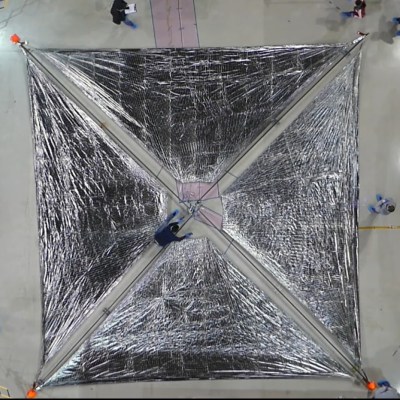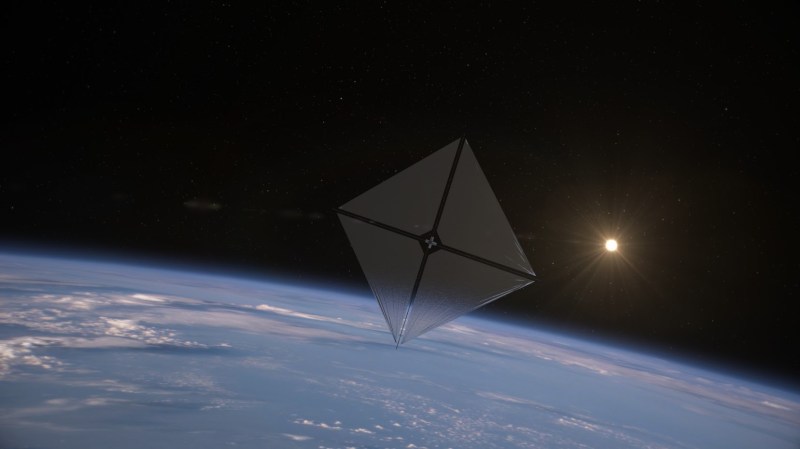NASA’s ACS3 (Advanced Composite Solar Sail System) is currently fully deployed in low Earth orbit, and stargazers can spot it if they know what to look for. It’s actually one of the brightest things in the night sky. When the conditions are right, anyway.

What conditions are those? Orientation, mostly. ACS3 is currently tumbling across the sky while NASA takes measurements about how it acts and moves. Once that’s done, the spacecraft will be stabilized. For now, it means that visibility depends on the ACS’s orientation relative to someone on the ground. At it’s brightest, it appears as bright as Sirius, the brightest star in the night sky.
ACS3 is part of NASA’s analysis and testing of solar sail technology for use in future missions. Solar sails represent a way of using reflected photons (from sunlight, but also possibly from a giant laser) for propulsion.
This perhaps doesn’t have much in the way of raw energy compared to traditional thrusters, but offers low cost and high efficiency (not to mention considerably lower complexity and weight) compared to propellant-based solutions. That makes it very worth investigating. Solar sail technology aims to send a probe to Alpha Centauri within the next twenty years.
Want to try to spot ACS3 with your own eyes? There’s a NASA app that can alert you to sighting opportunities in your local time and region, and even guide you toward the right region of the sky to look. Check it out!















“to send a probe to Alpha Centauri in the next twenty years.”
And how long will it take to get there? Centuries? Is there any hope that it will still be functioning after all that time?
It’ll depend on where the sail is launched from. If NASA puts in more for the rocket fuel and aim for Venus or even Mercury, the sail will get blasted with more protons from the sun than if they started by Earth and the probe will pick up speed quicker.
Let’s assume it will take 100 years. How will we communicate with it? How strong must the signal be? In the middle of the way it will take 2 years to reach earth – how to do any control over it? Most of technology will probably be long time dead – both software and hardware. Where to find engineers to troubleshoot? 100 years is enough for every possible social/political event to cancel the mission. Maybe even science will develop technology to travel so fast that new probe will be there faster – maybe even with people on board.
Bold idea – worth following even if will not finally happen.
Nah, 100 years isn’t that long, I think. I’m living a house that’s just as old.
I do also have books about crystal radios written in the 1920s and that Sharp MZ-80K computer here was made in 1978. That’s 46 years old, about half a century. It still works and manuals, schematics are all available.
Where there’s a will, there’s a way. Just don’t count on commercial organizations. Volunteers and non-profit organizations are more dependable. :)
With the Voyagers and Pioneers the problem was the transceiver unit used.
The transceiver technology (frequency, modulation type etc) at NASA deep space network was different from that of the Voyager era.
In simple words, none except one satellite dish antenna had been available to keep communication with Voyagers.
https://theconversation.com/voyager-2-has-lost-track-of-earth-only-one-antenna-in-the-world-can-help-it-phone-home-210882
But this was a home-made problem. There was no technological problem per se. If NASA had wanted to it could have built another compatible satellite dish antenna+transceiver unit using modern parts.
They hadn’t felt an urge to do this. That one antenna apparently was good enough to them.
So if a multi-generation mission is being planned eventually, the engineers will make sure the chosen transceiver technology will be in use for a long time.
They can design build and operate a space sail but the only way for the public to track it is an app? :(
I remember gathering outdoors to watch Echo 1 or 2 track by as timed in the newspaper. Echo was the first visible orbital object?
Umm which app? The page linked has about 7 . No description mentions ACS3?
For those of you wondering, much easier way of getting pass predictions is going to https://www.heavens-above.com set your location, then click the acs3 or whatever it is, no need to download some app and figure it out
Bonus you get passes for anything else in the night sky as well
hmm, just looked for Stockholm Sweden (=me) and tonight seems a pretty good night for seeing it. Passes from 20.26 to 20.32 between Stockholm and Helsinki as far as I can see, sun sets at 19.03 in Sthlm and it gets dark at 19.44. Seems lite the aatellite will be east of Sthlm, and so reflect the sun that just has set.
.
.
.
And, weather forecast says lots of clouds, of course. :(
https://www.heavens-above.com/gtrack.aspx?satid=59588&mjd=60569.7698207402&lat=59.3251&lng=18.0711&loc=Stockholms+kommun&alt=0&tz=CET
When a commercial operation puts something big and shiny up in orbit peeps were all “Oh oh light pollution, will somebody think of the poor astronomers!” But when NASA do it, nothing but the sound of crickets chirping.
Install an App to track it? So the app can track us?
important message to aliens: Don’t forget your sunglasses.
I installed the NASA app when this was first announced and it seemingly picks random times to notify that don’t match up with the times buried deep in the app’s interface in any meaningful way. My eyes have been somewhat more reliable.